Superman Returns was in 2005 theatres last weekend, or about 225 more theatres than The Devil Wears Prada was playing in, or about 1778. And yet Prada made more money, earning $4,774,000 with a $2600 average. Superman Returns made $3,570,000 with a $1700 average.
9/11 Comfort Blanket
Oliver Stone’s World Trade Center (Paramount, 8.9) is a well made, emotionally satisfying rescue movie. It happens to be about a couple of Port Authority cops (played by Nicolas Cage and Michael Pena) who got buried in the rubble of 9/11, but it could be about any two family men who nearly buy it while doing a tough job on a bad day.
It’s pretty much as screenwiter Andrea Berloff described it three or four months ago — a boy-down-the-well movie only darker and with blood and bruises and crushed bones, and times two. Not the most striking or labrynthian or emotionally complex film you’ve ever seen, but a good one.

Nicolas Cage as John McLoughlin in Oliver Stone’s World Trade Center
It’s spookier and less talky and certainly more traumatic than Ron Howard’s Apollo 13, but it’s basically the same thing. Brave guys get caught in it, seem fucked, are fucked, families think they’re fucked, a nervy guy with smarts and ingenuity is determined to save them, he finds a way, brave guys aren’t fucked after all and they’re home free and out. Otherwise there are loads of differences between Stone’s and Howard’s film, and one that stands out in particular: Apollo 13 has a more interesting story and a much stronger second act.
World Trade Center is about two guys trapped in a dark hole full of rocks and dirt and twisted metal, and the audience definitely shares their plight in the middle section. A feeling of being enveloped by despair and then hopelessness, a sensation of oxygen depletion, of being trapped with life slipping away. If this weren’t a grim-up-and-pay-attention 9/11 movie and was just an original script, agency readers would be writing the same thing all over town: “Great beginning, good ending…and a second act that literally lies there.”
< ?php include ('/home/hollyw9/public_html/wired'); ?>
Stone has directed World Trade Center like a champ and made it into something sharper and more shaded than what it probably was on the page. It could have been television — the bones are straight out of a made-for-TV movie manual — but it’s not. Nor is it the Second Coming. But because of the 9/11 baggage factor it’s being called a knockout and a cathartic wowser by both Time and Newsweek this week. And it’s not. Or at least, it didn’t feel that way to me.
By my standards World Trade Center is a solid 7.8. Not quite an 8, but absolutely nothing for anyone on the team not to be proud of, or at least very content with. I have no significant beefs with this film. I’d be surprised if anyone does. It’s not the kind of movie that will tick anyone off. It’s too decent and restrained and respectful and sharply rendered. But in a ground-rule-double sort of way.
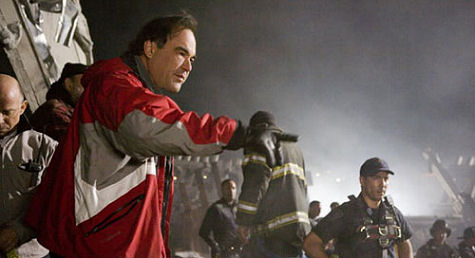
Oliver Stone on Playa del Rey set of World Trade Center
It’s very well acted up and down (Nicolas Cage, Maggie Gyllenhaal and Stephen Dorff are the best of a uniformly pro-level cast). The sense of 9/11 realism is bracing all the way through, and the visual effects are top-notch, by which I mean nearly invisible. (There’s an overhead shot of the smoldering World Trade Center site on Tuesday, 9.12, that’s one of the best non-fake-looking CG shots I’ve ever seen.) I really have to hand it again to Stone for doing an excellent job of “getting out of the way” and just directing it like a no-nonsense pro — as if the spirit of Anthony Mann swirled up from the grave and took over.
I think it’s fine that the patriotic right-wing community has been shown World Trade Center in advance screenings and that they’re digging it and all. I can see why. It has no politics, no Hollywood leftie attitude — it’s just a straight drama about a lot of good people pulling together to save a couple of guys from the jaws of death. A movie about caring, family, duty, perseverance.
Everybody knows Cage plays Port Authority cop John McLoughlin and Pena plays Will Jimeno, right? Two real-life guys who had to go through dozens of operations to recover from their 9/11 injuries, and who’ve been helping to promote the film that last several weeks.
The Newsweek story, written by critic David Ansen, says that World Trade Center “celebrates the ties that bind us, the bonds that keep us going, the goodness that stands as a rebuke to the horror of that day. Perhaps, in the future, the times will call for more challenging, or polemical, or subversive visions. Right now, it feels like the 9/11 movie we need.”
Not very challenging or polemical, and yet Newsweek has World Trade Center on the cover. It sounds like the editors might have been the ones doing cartwheels in the lobby rather than Ansen. Boil the snow out and all he’s saying is that WTC is classy emotional therapy.

Michael Shannon as Dave Karnes
I have one very small quibble with World Trade Center and two mid-sized ones. A tinkling of piano keys at the wrong moment near the beginning, and two small but significant omissions in the portrayal of Dave Karnes, the ex-Marine who drove in from Connecticut on the afternoon of 9/11 and made it through the police barriers and onto the WTC site by dinner hour.
It was Karnes (portrayed by Michael Shannon) who discovered McLoughlin and Jimeno and brought the rescue teams to their aid. Everybody had quit looking that night for fear of other buildings collapsing. If Karnes hadn’t put on his Marine uniform and gotten himself a Marine haircut at a Stamford barbershop and driven down to Manhattan and all, it’s quite possible McLoughlin and Jimeno might not have survived. Shannon portrays him as a bit of a religious weirdo, a bit of a nut. But a good kind of nut in a situation like 9/11 — a guy who laser-beams right into what needs to be done, and then does it.
Curiously, Stone decided to omit a character detail that I find really interesting. Karnes drove into Manhattan in a recently purchased Porsche 911 convertible, and at times, according to a 9.02 Slate story by Rebeca Liss, at speeds of 120 mph.
That’s a fascinating trait for a 9/11 savior — tear-assing down the Connecticut Turn- plike and the Henry Hudson Parkway in a muscle car with the top down, and stop- ping at a McDonald’s along the way.
Why didn’t Stone show this? My theory is that he wanted Karnes to appear selfless and monk-like — a slightly bent military saint. And I think he knew this impression wouldn’t fly with audiences if he had Karnes driving a Porsche 911 because a lot of people think that guys who drive Porsches are dickheads. But I had read about Karnes and his Porsche two or three years ago and was waiting for that shot. I felt that Stone sold Karnes and his audience short by trying to simplify him into a ex-Marine who resembled Karnes in a lot of ways but not entirely.
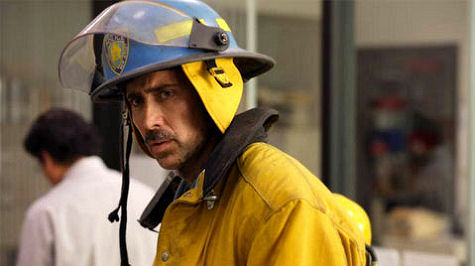
There’s another thing that happened between Karnes and the men he saved that Stone chose not to dramatize. It would have been touching. Liss describes it thusly:
“Karnes left the site that night when Jimeno was rescued and went with him to the hospital. While doctors treated the injured cop, Karnes grabbed a few hours sleep on an empty bed in the hospital psychiatric ward. While he slept, the hospital cleaned and pressed his uniform.”
The little thing I didn’t like is a bit at the very beginning when Cage is dressing and getting ready to drive to work from his home in New Jersey. The movie has been running for maybe four or five minutes as he walks down a hallway and opens a door and looks into the bedrooms of his sleeping children. And Stone ruins the moment by putting a “sensitive” little piano riff on the soundtrack. Sensitive as in “awww, he loves his children” and “boy, the quiet little moments in life are what make it all worth it, you know?”
Without the tinkling piano it would have been a nice honest little moment — with the tinkling piano it’s Hollywood bullshit. It’s okay to use tinkling piano riffs to emphasize emotion but only after the film has been running for 15 or 20 minutes, by which time you’ve built up your characters and plot elements a little bit.
There’s a perfect little piano tinkle when Gloria Stuart’s “old Rose” first looks at Jack Dawson’s old drawing of her naked younger self in Titanic, but because we’ve gotten to know a bit about her character and who she is, and because we don’t exactly know what the piano tinkle means…but we can tell it means something. And so it gets us on some level.

Michael Pena as Jim Jimeno
I seem to have lost my World Trade Center thread here….
At least I haven’t oversold the thing. If you go and feel this afterwards, blame Ansen and Time‘s Richard Schickel.
Addendum: I happened to meet Mcloughlin’s real-life son on the Paramount lot after seeing World Trade Center a couple of weeks ago. He was with a couple of friends in a small white car. We shook hands and talked about the film a bit. I asked if his dad has been in touch with Karnes since 9.11 and I think he said “once.” I asked why Cage portrayed his dad as walking in an awkward stumpy fashion at the end of the film, and he said it’s because the bones in his dad’s feet were totally crushed and aren’t flexible and that he basically “walks around like Frankenstein.”
Mel Gibson has checked into a rehab facility for his alcohol problem, as reported by the Star‘s Lee Hannon and confirmed by his publicist Alan Neirob. However, a neighbor quoted in the story thinks Gibson has gone into the wrong rehab facility. If you want to read about this, here you go.

A South Park Mel Gibson segment via UTube, obviously made with The Passion of the Christ in mind. Moderately funny (okay, more than moderately), but Matt and Trey need to make a new “sugar tits and bad Jews” version.
That rumor about Heath Ledger being cast as the Joker in the next Batman movie has turned out to be true. A Warner Bros. publicist told me ten minutes ago the next Batman flick for Warner Bros. will be called The Dark Knight, and that Chris Nolan will again direct, and that Ledger will indeed play the infamous cackling twisted baddie who has it in for Batman, etc. Big payday for Heath, obviously — doing it for his kid, and because he always seems to enjoy going weird and quirky. An official release will be sent out tomorrow. The publicist told me to call her for more details but she didn’t include her extension or her cell and…forget it. I’ll post the rest tomorrow.
Here’s a fairly good review of Apocalypse Now: The Complete Triple Dip, the DVD containing both the original theatrical and the Redux versions of Francis Coppola‘s 1979 classic. I’m kidding about the DVD’s subtitle — it’s actually called The Complete Dossier.

The most exciting extra for a lot of people will be a full 17-minute reading of T.S. Eliot‘s “The Hollow Men” by Marlon Brando. There are also 13 deleted scenes, including one called “Monkey Sampan” One, deemed “a notoriously hard-to-find relic from the film√ɬ¢√¢‚Äö¬¨√¢‚Äû¬¢s original construction” plus 12 additional sequences are not available in either the original or Redux versions
Apocalypse Now was shot in 70mm and was initially shown in the correct widescreen 70mm aspect ratio of 2.21 to 1. This new DVD has Apocalypse trimmed down to 2.35 to 1, which sounds like they’ve chopped off the tops and bottoms slightly. I saw it in 70mm at the Ziegeld 27 years ago and I know they showed it at 2.21 to 1 during that engagement and they wouldn’t have done this if it hadn’t been cool with Francis and the powers-that-be, so anyone who says a 2.35 to 1 presentation is somehow better or more complete is wrong. I’m always disagreeing with people who think it’s better to show a film with the tops and bottoms chopped off. Give it air, I always say. Give the actors a little headroom.
To be a really complete Apocalypse dossier, of course, George Hickenlooper and Fax Bahr‘s Heart of Darkness — a brilliant documentary about the tortured making of the film — should have been included, and of course it hasn’t been

Only a week or so on the job and Disney production chief Oren Aviv has already defined himself as a disciplined dispenser of carefully composed (read: disengenuous) press statements.
First he told N.Y. Times reporter Laura Holson that he was “surprised when Disney chairman Dick Cook asked him…to succeed [Nina] Jacobson” and that he “never asked for [the] job.” Now he’s telling Slate‘s Kim Masters that he’s ready to look past Mel Gibson’s attitudes about Jews. “I’ve worked with Mel on several films over the years and we have a great relationship, ” he said. “We all make mistakes and I’ve accepted his apology to what was a regrettable situation. I wish him the very best on his path to healing.”
That’s a nice Christian comradely thing to say, and also a necessary thing considering that Disney is stuck with the task of distributing Gibson’s Apocalypto, but there’s an art to bullshitting the press that Aviv hasn’t gotten the hang of yet. You have to try and sound like someone who hasn’t rehearsed his quotes ten times over before picking up the phone. Every now and then you have to just blurt something out that sounds tossed-off and what-the-hellish and and 90% true. If you say too many half-true, half-horseshit statements, reporters will get wind of your character sooner or later and then they’ll stop listening.
The anti-Jewish thing has been tattooed into Mel Gibson’s forehead and there’s no laser procedure that will remove it. There’s only one way to deal with it, and that’s what Henry II did after Thomas Becket was murdered. Gibson needs to do penance. He needs to visit a prominent temple, take his shirt off, kneel on the stone floor and submit to lashings by a team of rabbis. Repeatedly, I mean. For weeks and probably months to come. He needs to make a show of groveling at the feet of Hollywood’s Jewish bigwigs. That’s the only thing that will even half-assedly begin to get him off the hook . Me bad, me anti-Semite, me looking for guidance. Question is, does he have the character or the will to do that?
An Access Hollywood piece set to air this evening reportedly quotes Lindsay Lohan‘s manager-mom Dina as saying that the wording in the letter sent to her daughter last week (i.e., the one warning Lindsay to cool it on the partying and missing work or else) by Morgan Creek honcho James Robinson was “way out of line” and “ridiculous.” She reportedly added, “Maybe [Robinson] has personal issues with whomever and it came out with my child. I don’t know him. I can’t judge him. I don’t think it was a smart thing to do to a young girl.”

Speaking as a parent, this tells me three things are probably in place. One, Dina is dug into the role of being her daughter’s friend and supporter as opposed to being her parent, and this mindset doesn’t allow for dealing with her daughter’s issues. Two, she’s probably some kind of seminal laissez-faire provocateur as far as her daughter’s past nocturnal proclivities are concerned. And three, she’s a present-tense enabler of same. When (I’m not even saying “if”) Lindsay winds up with the inevitable substance-abuse issues and goes into rehab and all that, there will probably be people other than her mom who will provide the right kind of counsel and support. I mean, look at Dina’s photo above (she’s the blonde on the right). Consider that smile on her face. She’s obviously a hottie who’s obviously open to glamour and lusciousness and sparkling encounters.

Here’s the Save-the-River-Oaks-theatre petition site, and here’s another Houston Chronicle article (it ran last Friday, 7.28) about the public clamor to try and save this beautiful old theatre with the beautiful red-and-yellow neon marquee. Over the last ten days or so the online petition (sponsored by the Houstonist.com site, although you’d never know it by looking at the petition page) has close to 14,000 signers.

The Chronicle story also reports that City Councilwoman Ada Edwards and “other council members” hope to persuade Houston-based Weingarten Realty Investors to change its plans. Nobody is going to “persuade” the Weingarten gang to change anything — pressure that threatens their pocketbook is the only thing that big-wheel developers understand.
Make no mistake — the Weingarten executives who are running the local Houston show are the bad guys in this story. They want to impose unwanted, culturally- damaging change upon the only section of Houston has has any real sense of architectural soul, and concerned citizens are uniting in opposition to this. The possibility of the River Oaks theatre being destroyed is not a benign act of nature — it’s a matter of deliberate will on the part of some obviously greedy people. And if you ask me the following pro-River Oaks statement, issued by Landmark Theatres CEO Bill Banowsky, strikes me as rather wishy-washy in the face of this:
“Landmark Theatres is 100% committed to the historic River Oaks Theatre. We hope to continue to serve Houston residents with the best in quality art and independent film for a very long time. Landmark Theatres upholds a strong tradition of saving and restoring old movie palaces. We’ve accomplished this with the River Oaks Theatre and many other beautiful theaters across the country. We believe this to be a worthy undertaking for the appreciative audiences in the communities we serve. It is their support that has enabled Landmark Theatres to bring these wonderful buildings back to life.”
If Landmark was “100% committed to the historic River Oaks theatre”, wouldn’t you think they’d issue a statement with a bit more fighting spirit…that wasn’t so generically bland?
Hard-nosed assessments of Mel Gibson‘s compromised reputation by (a) Endeavor agent Ari Emanuel, (b) L.A. Times guys Robert Welkos and John Horn, (c) Variety‘s Gabriel Snyder, and (d) the Hollywood Reporter‘s Anne Thompson. Plus two stories about this — the list is getting longer by the minute — by USA Today‘s Anthony Breznican.
The judgment is basically that Gibson’s Apocalypto (Disney, 12.8) is over as an Oscar contender — when Gibson campaigns he’ll be asked over and over about the anti-Semitic remarks and not the film, etc. — and that he has major career-repair work in front of him, to say the least. There’s even some rumbling about Disney possibly wanting to bail on its Apocalypto distribution deal. Seems doubtful. Who wouldn’t want to see it now? Out of major curiosity if nothing else?
I get all this and the people who are saying Apocalypto is toast as an awards contender probably aren’t wrong, but one question: what if turns out to be an exceptionally good and profound film? There are indications it may not be. (MCN’s David Poland, who has long criticized journos and columnists for making negative assumptions about movies that haven’t been seen and/or have had their release dates delayed, told Breznican “It could be bad enough that the movie has to be pushed [to a different date].”) But what if the indications are wrong and it turns out to be something out-of-the-park special? No matter, apparently. Gibson’s name is mud and that’s pretty much it. For now.
It’s been 22 years since the first Miami Vice season on the tube in ’84-’85, and I never rented the February ’05 Vice DVD that had that entire season on it. But reader Dewey Yeatts of Whitehall, PA, is saying that Michael Mann‘s just released Miami Vice features is based on a February ’85 Vice episode called “Smuggler’s Blues,” in much the same way that Mann’s Heat (’95) was a big-star feature version of the 1989 TV movie he wrote and directed called “L.A. Takedown.”

Is there anyone who’s seen the big-screen Vice who also remembers “Smuggler’s Blues” in detail? And if so, does Yeatts have it right?
Here are Dewey’s similarites: (1) The movie and the episode “both open with the death of a drug runner/informant and his family”; (2) “What follows is a federal officer pulling Crockett and Tubbs into a secret meeting also attended by Lt. Castillo. In both versions, the Fed knows about a leak in the system, and pleads with Crockett and Tubbs to go undercover and make contact with a drug lord”; (3) “In both versions, they hit the underworld to obtain transportation (in the TV show, they wind up in a plane piloted by Glenn Frey — in the movie, they go to work on the competition’s ‘go fast boats’ and then fly their own plane to Latin America)”; (4) “They then make contact with a drug lord, and the meetings in both versions are weird (though for different reasons”; (5) “After the meeting they go back to their seedy hotel room and check the doors and windows. (To my eye, the room in the movie seemed to be the exact same one from the episode — the movements of the detectives seem very similar during the sequence.)”
“The movie at this point sets up more twists and plot points, which is normal, since the film has nearly three times the running time of the episode,” Yeatts writes. “But Crockett’s seduction of Gong Li’s Isabella is right out of the TV show’s playbook. How many episodes involved around romantic entanglements that dovetailed with the “case”? And how many episodes revolved around one of the girl detectives being put in danger? (See next item…)
“In the TV episode, on the partners’ return to America, Trudy is taken hostage by the bad guys and wired for explosives. In the movie, upon the partners’ return to America, Trudy is taken hostage by the bad guys and wired for explosives. (It should be noted the radical difference in the way these scenes are handled in each version.)

“To my mind, the film may have lacked the show’s pastel fashions, had hipper music (in 20 years will the movie soundtrack seem dated? Of course it will) and almost zero humor (though I felt there were a few dry lines that crackled.) But overall, the movie to me played like a larger-scale episode. The story beats from “Smuggler’s Blues.” The romantic issues. The lady-detective-in-peril. Scenes of cars and boats going very very fast. (Mann did resist the urge to go Phil Collins on us however.) The end, where they are to meet at a point along the river, reminded me of a similar sequence in the pilot episode.
“In the end, Mann did not make an homage — he just made a better version of what was already pretty cool and cutting edge. The fact that all the major cop characters had exactly the same names (Switek, Zito, etc.) says that Mann was not turning his back on his creation — just enhancing it.”
“One last thing: although the Cro-Magnon audience I saw the film with was restless at times (you don’t want to know about Friday night screenings in my neck of the woods`– mouth breathers, the lot of them), the crackerjack third act (the siege in the trailer, the firework-laden finale) sent them out of the theater crackling. So the word of mouth may be better than you think. Let’s hope so. This is the movie that should get a sequel.”

<div style="background:#fff;padding:7px;"><a href="https://hollywood-elsewhere.com/category/reviews/"><img src=
"https://hollywood-elsewhere.com/wp-content/uploads/2019/08/reviews.jpg"></a></div>
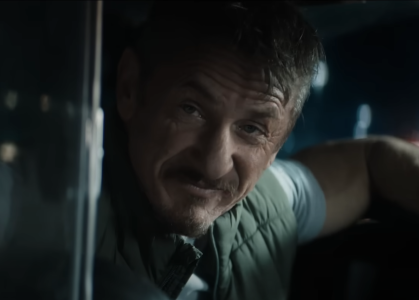 Really Nice Ride
Really Nice RideTo my great surprise and delight, Christy Hall‘s Daddio, which I was remiss in not seeing during last year’s Telluride...
More »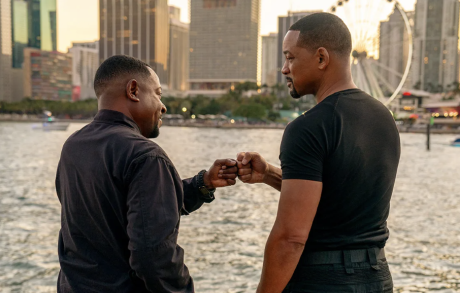 Live-Blogging “Bad Boys: Ride or Die”
Live-Blogging “Bad Boys: Ride or Die”7:45 pm: Okay, the initial light-hearted section (repartee, wedding, hospital, afterlife Joey Pants, healthy diet) was enjoyable, but Jesus, when...
More » One of the Better Apes Franchise Flicks
One of the Better Apes Franchise FlicksIt took me a full month to see Wes Ball and Josh Friedman‘s Kingdom of the Planet of the Apes...
More »
<div style="background:#fff;padding:7px;"><a href="https://hollywood-elsewhere.com/category/classic/"><img src="https://hollywood-elsewhere.com/wp-content/uploads/2019/08/heclassic-1-e1492633312403.jpg"></div>
- The Pull of Exceptional History
The Kamala surge is, I believe, mainly about two things — (a) people feeling lit up or joyful about being...
More » 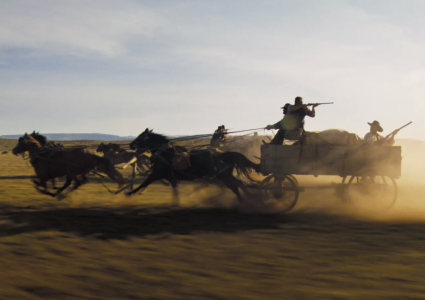 If I Was Costner, I’d Probably Throw In The Towel
If I Was Costner, I’d Probably Throw In The TowelUnless Part Two of Kevin Costner‘s Horizon (Warner Bros., 8.16) somehow improves upon the sluggish initial installment and delivers something...
More » Delicious, Demonic Otto Gross
Delicious, Demonic Otto GrossFor me, A Dangerous Method (2011) is David Cronenberg‘s tastiest and wickedest film — intense, sexually upfront and occasionally arousing...
More »


